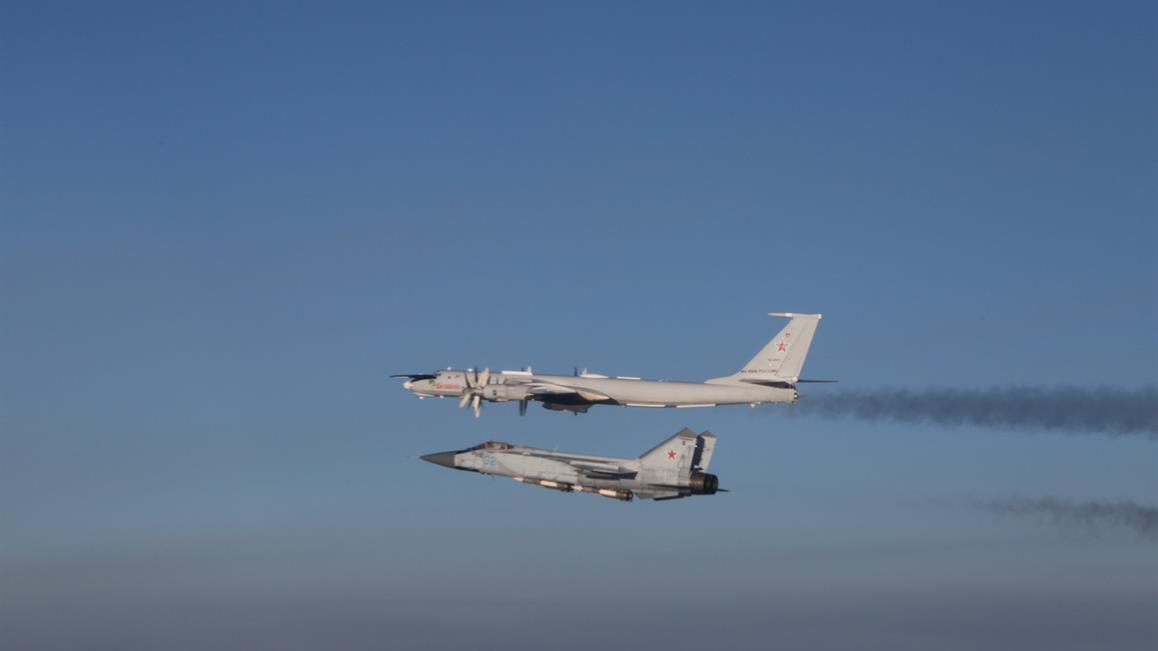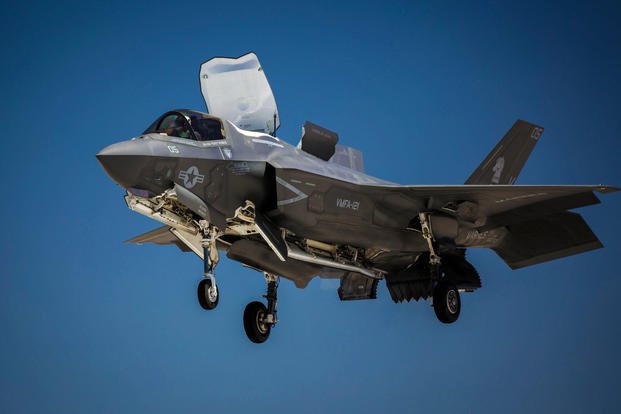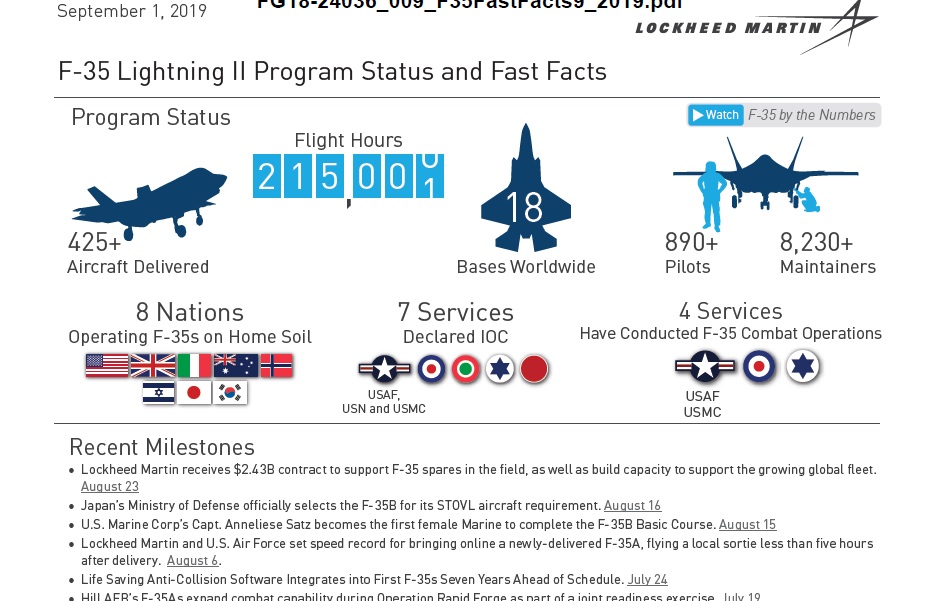How to install the app on iOS
Follow along with the video below to see how to install our site as a web app on your home screen.
Note: This feature may not be available in some browsers.
You are using an out of date browser. It may not display this or other websites correctly.
You should upgrade or use an alternative browser.
You should upgrade or use an alternative browser.
F-22 / F-35 5th Generation jets | News & Discussions.
- Thread starter Lankan Ranger
- Start date
Haris Ali2140
SENIOR MEMBER

- Joined
- May 20, 2019
- Messages
- 4,143
- Reaction score
- 1
- Country
- Location
So Turkey is officially out???
gambit
PROFESSIONAL

- Joined
- Apr 28, 2009
- Messages
- 28,569
- Reaction score
- 148
- Country
- Location
For yrs, it has been difficult to somehow effectively convey -- in a visual format -- of how difficult it is to detect a DELIBERATELY designed body for low radar observability, aka 'stealth'. Most of the public have never seen a radar system in operation, let alone a radar under military direction. Most commentaries and public articles about radar in general and 'stealth' in particular often mention 'noise' as how a 'stealth' fighter would exploit to remain hidden. But how to sufficiently represent that difficulty?
It is true that background electromagnetic (EM) noise is important for 'stealth'. The body is shaped in such a way that it reflects/deflects MOST radar signals away from the seeking radar. That is most, not all. Whatever small amount of reflected/deflected EM signals that made the return journey to the seeking radar is usually dismissed by the radar computer as 'noise'. In essence, the 'stealth' fighter is actually 'seen' by the seeking radar, but that it is categorized as 'noise'. But how to sufficiently represent that process without involving a lot of math and time explaining to the interested laymen?
Most explanation of 'noise' uses something like this...

There is nothing wrong with that. But many people still have difficulty imagining the 'stealth' fighter inside all those lines. We learn the quickest, if not the most in-depth, via visualization. That is why we use symbols, from flags to drawings, to TRY to convey messages in as little effort as possible. Every American know the 50 stars on the flag represents the 50 states. Every JPNese know the solid red circle on their flag represents the sun. And so on...
So after all this time, I managed to find an image that I believe is the best representation of 'stealth', including how 'stealth' is hidden among background EM noise...

Background EM noise is neither uniform nor level. In the image above, a man body painted himself to look like rocks. His face is pointed out. His eyes, nostrils, and mouth are barely discernible, if not assisted by the pointer. Given enough time, the viewer can mentally outline his arms and legs, but by the time he can do so, a missile or a bomb is well on the way. All those visual tests on how to find a camouflaged sniper in a field of grass or on a mountainside do not really represent the true electrical nature of EM background noise -- intensely messy like the image above.
Every REAL rock is the equivalent of an unknown EM background signal that the radar computer classified as 'noise'. Together, all the rocks would overwhelm the radar computer, or in this case, the human brain, in trying to discern a pattern. Note that you can actually see the man, you as the seeking radar, but your brain have difficulty trying to find a pattern in all those disorganized rocks. Different persons will have different time spent in trying to outline the man's body. No different than how different radar designs would have difficulty finding the 'stealth' fighter signals from background 'noise'. Those who mock 'stealth' in saying 'overrated', or even does not work, are ignorant and do not know what they are talking about, not even of basic radar principles.
Low radar observability does work and is a very real threat.
It is true that background electromagnetic (EM) noise is important for 'stealth'. The body is shaped in such a way that it reflects/deflects MOST radar signals away from the seeking radar. That is most, not all. Whatever small amount of reflected/deflected EM signals that made the return journey to the seeking radar is usually dismissed by the radar computer as 'noise'. In essence, the 'stealth' fighter is actually 'seen' by the seeking radar, but that it is categorized as 'noise'. But how to sufficiently represent that process without involving a lot of math and time explaining to the interested laymen?
Most explanation of 'noise' uses something like this...

There is nothing wrong with that. But many people still have difficulty imagining the 'stealth' fighter inside all those lines. We learn the quickest, if not the most in-depth, via visualization. That is why we use symbols, from flags to drawings, to TRY to convey messages in as little effort as possible. Every American know the 50 stars on the flag represents the 50 states. Every JPNese know the solid red circle on their flag represents the sun. And so on...
So after all this time, I managed to find an image that I believe is the best representation of 'stealth', including how 'stealth' is hidden among background EM noise...

Background EM noise is neither uniform nor level. In the image above, a man body painted himself to look like rocks. His face is pointed out. His eyes, nostrils, and mouth are barely discernible, if not assisted by the pointer. Given enough time, the viewer can mentally outline his arms and legs, but by the time he can do so, a missile or a bomb is well on the way. All those visual tests on how to find a camouflaged sniper in a field of grass or on a mountainside do not really represent the true electrical nature of EM background noise -- intensely messy like the image above.
Every REAL rock is the equivalent of an unknown EM background signal that the radar computer classified as 'noise'. Together, all the rocks would overwhelm the radar computer, or in this case, the human brain, in trying to discern a pattern. Note that you can actually see the man, you as the seeking radar, but your brain have difficulty trying to find a pattern in all those disorganized rocks. Different persons will have different time spent in trying to outline the man's body. No different than how different radar designs would have difficulty finding the 'stealth' fighter signals from background 'noise'. Those who mock 'stealth' in saying 'overrated', or even does not work, are ignorant and do not know what they are talking about, not even of basic radar principles.
Low radar observability does work and is a very real threat.
500
BANNED

- Joined
- Aug 18, 2010
- Messages
- 16,678
- Reaction score
- 38
- Country
- Location
With more than 490 aircraft operating from 21 bases around the globe, the F-35 plays a critical role in today’s global security environment.
Today, 975 pilots and 8,585 maintainers are trained, and the F-35 fleet has surpassed more than 240,000 cumulative flight hours. Eight nations have F-35s operating from a base on their home soil, eight services have declared Initial Operating Capability and four services have employed F-35s in combat operations.
https://apnews.com/PR Newswire/eddfbcd31df938cc4d1b4d050315b253
Today, 975 pilots and 8,585 maintainers are trained, and the F-35 fleet has surpassed more than 240,000 cumulative flight hours. Eight nations have F-35s operating from a base on their home soil, eight services have declared Initial Operating Capability and four services have employed F-35s in combat operations.
https://apnews.com/PR Newswire/eddfbcd31df938cc4d1b4d050315b253
500
BANNED

- Joined
- Aug 18, 2010
- Messages
- 16,678
- Reaction score
- 38
- Country
- Location
Pax Ottomana
FULL MEMBER

- Joined
- Dec 26, 2009
- Messages
- 1,639
- Reaction score
- -3
- Country
- Location
F-35 Design Flaws Mounting, New Document Shows
https://www.pogo.org/investigation/2020/03/f-35-design-flaws-mounting-new-document-shows/

https://www.pogo.org/investigation/2020/03/f-35-design-flaws-mounting-new-document-shows/

Sohail Qamar Photography
FULL MEMBER

- Joined
- Jun 6, 2019
- Messages
- 395
- Reaction score
- 1
- Country
- Location
Ymir
FULL MEMBER
New Recruit
- Joined
- May 27, 2020
- Messages
- 13
- Reaction score
- 0
- Country
- Location
Norway currently has 4 of its F-35As stationed in Iceland as part of NATO's Icelandic Air Policing mission.








Interceptions of Russian aircraft have already occurred, the most recent of which were a MiG-31 and a TU-142R









Interceptions of Russian aircraft have already occurred, the most recent of which were a MiG-31 and a TU-142R

Hamartia Antidote
ELITE MEMBER

- Joined
- Nov 17, 2013
- Messages
- 35,188
- Reaction score
- 30
- Country
- Location
Hamartia Antidote
ELITE MEMBER

- Joined
- Nov 17, 2013
- Messages
- 35,188
- Reaction score
- 30
- Country
- Location

Watch An F-35 Drop A B61 Nuclear Bomb In This First-Ever Declassified Video
The supersonic drop test puts the F-35A a step closer to being able to employ the new nukes, which are literally worth more than their weight in gold.
dexter
SENIOR MEMBER

- Joined
- Apr 17, 2009
- Messages
- 6,111
- Reaction score
- 25
- Country
- Location
The Joint Strike Fighter is the most expensive weapons program ever devised. Costing well over a trillion dollars, the F-35 was supposed to replace the frontline fighters for the U.S. Navy, Marines, and Air Force. But costly delays and setbacks have potentially pushed the Air Force to look for a cheaper option to help fill in the gaps left by the expensive F-35A.
Correction (March 19, 2021): At 5:30 the video misstates the cost of the program at $1.6 trillion to-date. The correct number is $1.6 trillion over the lifetime of the program.
The F-35A was designed to revolutionize fighter procurement. It was going to take the missions of several aircraft and do it all. The maintenance was going to be cheaper and easier due to cutting edge computer software. The list of planes it was going to replace was long. But the operating costs for the aircraft, which is around $36,000 per hour, are still around $10,000 more expensive than older fighters in the Air Force inventory.
“The biggest cost challenge that we face in the airplane is the life cycle sustainment cost of the jet. What I can tell you...is the Air Force is laser focused on that.” Said Brigadier General Abba, who is the Director of the F-35 integration office for the U.S. Air Force. “When we are talking about the cost per flying hour of an F-35, it includes all of those sorts of capabilities that in other airplanes, F-16, F-15, that are not organic to the platform itself. They're things that hang either on centerline stations or on wing stations to help the airplane accomplish its mission.”
Although the F-35 is an incredibly capable aircraft, the Air Force appears to have decided to diversify its fleet. The F-15EX, an upgraded version of the F-15 that first flew in the 1970s is on the acquisition block, and the initial F-15EX was delivered to the Air Force this month. And recent comments by the Air Force Chief of Staff, General Charles Brown Jr., illustrated the possibility of procuring a light fighter to be a replacement for the aging F-16.
“The idea that, you know, because there are some affordability challenges that the USA is somehow going to just bail on this program is mad.” Said Justin Bronk, a Airpower and Technology Research Fellow at the Royal United Services Institute. “Of course, they have to consider the future flights it makes because the sums don't add up and they haven't had it up for a long time. And good on General Brown for grasping the mettle on that publicly.”
T-SaGe
FULL MEMBER

- Joined
- Feb 25, 2021
- Messages
- 721
- Reaction score
- 2
- Country
- Location
A Marine F-35B Fighter Jet Accidentally Shot Itself With Its Own Gun Pod

 www.military.com
www.military.com
Underside of a U.S. Marine Corps F-35B Joint Strike Fighter was significantly damaged when a round fired from its underbelly 25mm gun pod exploded shortly after leaving the muzzle of the cannon mounted within. The accident, which occurred over the Yuma Range Complex in Arizona earlier this month, did not injure the pilot of the jet, who was able to bring the aircraft safely back to base.

Marine Corps F-35B in Arizona Damaged by Round Discharged from Jet Cannon
An ammunition round that exploded following its discharge from a Marine Corps F-35B Joint Strike Fighter at Marine Corps Air Station Yuma, Arizona, earlier this month caused damage to the stealth fighter's fuselage.
Underside of a U.S. Marine Corps F-35B Joint Strike Fighter was significantly damaged when a round fired from its underbelly 25mm gun pod exploded shortly after leaving the muzzle of the cannon mounted within. The accident, which occurred over the Yuma Range Complex in Arizona earlier this month, did not injure the pilot of the jet, who was able to bring the aircraft safely back to base.
Similar threads
- Replies
- 3
- Views
- 544
- Replies
- 0
- Views
- 331
- Replies
- 7
- Views
- 530
- Replies
- 4
- Views
- 565
Latest posts
-
-
-
Pakistan military officer sues Adil Raja for defamation in unprecedented UK action
- Latest: muhammadhafeezmalik
-
Pakistan Affairs Latest Posts
-
Pakistan military officer sues Adil Raja for defamation in unprecedented UK action
- Latest: muhammadhafeezmalik
-




